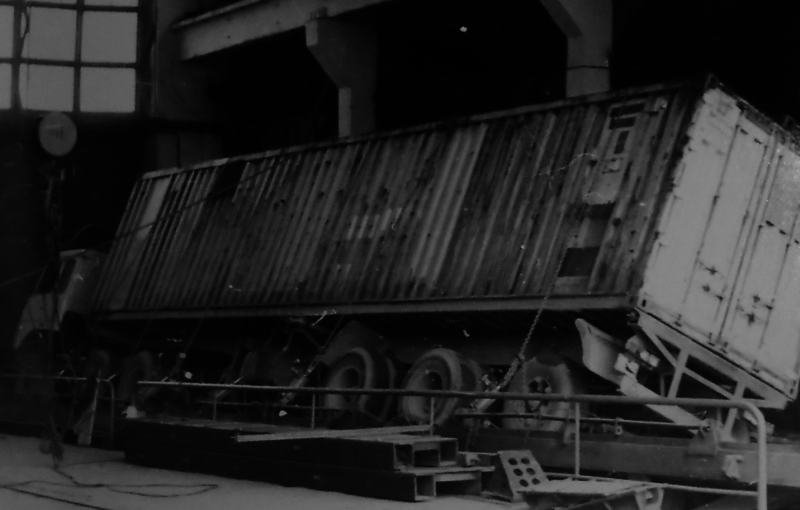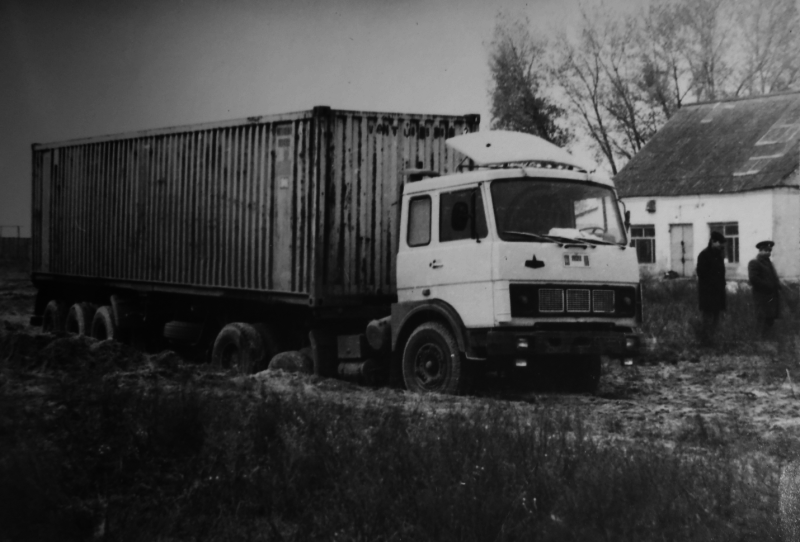The project of mobile courier rocket complex
In the early eighties at the Moscow Institute of Thermal Engineering (MIT) one of the new projects of the mobile ground-based missile complex was launched. According to some information, it was originally called Temp-SM, but later received a new designation - 15P159 "Courier". It is under this name that the project entered history domestic rocket technology. The Courier Project was a response to the Midgetman American program. Since 1983, American specialists have been developing a mobile missile system armed with an intercontinental ballistic missile with a range of at least 10 thousand km. An important feature of the Midgetman project was the limitations on the size and launch weight of the rocket. The latter, in the state ready for launch, should have weighed no more than 15-17 t.

This is exactly the unit that was tested. The only thing that is corrected in the photo - his number is removed
21 July 1983 of the year issued a decree of the USSR Council of Ministers, according to which MIT had to develop a missile system with similar characteristics. Restrictions on the size and launch weight of the rocket, while complicating the development, could have a number of positive consequences. Studies have shown that a relatively small rocket can be used not only with mine launchers or machines based on special chassis. The carriers of the product "Courier" could become special automotive semi-trailers or containers of standard sizes and trains. In addition, the transportation of missiles by military transport aircraft was facilitated.
The initiator and one of the main supporters of the new project was Commander of the Strategic Missile Forces V.F. Tolubko. The head of the “Courier” project was A.D. Nadiradze In 1987, his place was taken by B.N. Lagutin. The Votkinsk Machine-Building Plant was involved in the project, which first had to build the required number of experienced rockets, and then master the mass production of new products. Tests and the start of mass production of the Kurier missile complexes were planned for the beginning of the nineties.
The main element of the complex was to be an intercontinental ballistic missile 15Ж59 "Courier". The specific requirements for this product forced MIT and related organizations to conduct a large amount of research and testing, to master new materials and technologies. So, it is known that the newest composite materials were widely used in the design of the rocket body, and the instrumentation equipment had to be built on the basis of the most modern element base. Thus, the Courier missile system could be considered a representative of a new generation of systems of its class.
According to a number of sources, the 15ЖХNNXX rocket was to be built in a three-stage scheme with a separate breeding stage. All stages of the product were supposed to be equipped with solid-fuel rocket engines using a new type of fuel. In the design of the engines, in order to reduce their dimensions, the nozzles partially recessed into the body could be used. In the head part there should have been a stage of breeding with a payload.
Rocket "Courier" was obtained uniquely compact. Its length did not exceed 11,2 m, and the maximum case diameter was 1,36 m. In the early stages of the project, it was supposed to “fit” the starting weight at 15 t, but later it had to be increased to 17 t. The drop weight was about 500 kg. The 15ЖХ59 missile was supposed to carry a monoblock warhead with a nuclear warhead of no more than 150 kt.
For guidance, the Courier rocket was supposed to use an inertial guidance system, made on the basis of a modern element base. As the controls could be used rotary nozzles of the engines and the grating rudders of the first stage.
According to reports, despite the small weight and size, the promising intercontinental missile "Courier" was supposed to deliver a warhead to a range of 10-11 thousand km. The circular deviation should not exceed 350-400 m.
At the factory, the rocket had to be loaded into a transport-launch container, which was supposed to be mounted on the lifting mechanisms of a self-propelled launcher. The launcher itself was proposed to be built on the basis of a special multi-axle chassis with the corresponding characteristics. During the development of the project, the appearance of the chassis was constantly changing. In the complex "Courier" could use the chassis with three, four and five axles. According to one source, it was first suggested to use the 6x6 chassis, but then, due to certain difficulties, it was necessary to develop and integrate machines with a more complex chassis into the complex. According to others, the first appeared six-axle (!) Chassis, after the design of which there was a proposal to reduce the base machine by several wheel pairs.
Since almost all the documentation for the “Courier” project is still classified, it is difficult to say which version corresponds to reality. Both versions seem plausible, since all the chassis, mentioned in the context of the “Courier” project, were really developed and tested. So, it was proposed to make a six-axle mobile launcher based on the MAZ-7916 chassis, a five-axis one based on the MAZ-7929, a four-axis one - the MAZ-7909.
Sources describing a consistent decrease in the number of axles provide some details of this process. So, initially the units of the Courier complex were to be mounted on the basis of the MAZ-7916, but already at the beginning of 1985, it was proposed to use a promising five-axle chassis, which did not exist yet. In the spring of the same year they proposed to develop the 6x6 and 8x8 chassis, and in April 86-nd decided to build a four-axle chassis. However, such a machine did not fully meet the requirements of the military, which is why at the beginning of 1988, they decided to build a launcher based on the five-axle MAZ-7929. This machine has received an index 15У160М.
Fluctuations with the choice of the base chassis affected the timing of the development of the launcher. The five-axle machine project was completed only in 1991, after which MAZ supplied the necessary equipment to Volgograd’s Barricades, where they were to install a set of special equipment.
Special attention deserves a special version of the complex "Courier", intended for the hidden transfer of missiles in a given area. The small weight and dimensions of the product allowed the rocket to be placed in a specially equipped standard cargo container or automobile semi-trailer. Such a self-propelled launcher could, without attracting attention, move throughout the country and, in the case of receiving an order, to launch.
The MAZ-6422 truck tractor and the MAZ-9389 semi-trailer were chosen as the base for the camouflaged modification of the complex. An interesting fact is that the development of the “automotive” modification of the new missile complex began shortly after the start of the project and the bulk of the work was carried out long before the final selection of the chassis for the mobile launcher of the “classical” type.
Already in September, the 1984 of the year at the test site in Bronnitsy (Moscow region) carried out preliminary tests of the proposed tractor and trailer. At the end of the first stage of testing, the truck was distilled into the Gomel region, where for a long time he traveled along local routes. The testing ground was the Leningrad-Kiev-Odessa route (with two bridges), Minsk-Gomel and Bryansk-Gomel-Kobrin.
During the tests, experts collected various information about the operation of the machine’s units, its characteristics, as well as the resulting loads on objects in the semi-trailer, etc. According to the test results, a list of requirements for the equipment that was supposed to be transported in an automobile semi-trailer was formed. The collected data were actively used in the development of the 15Ж59 rocket and other elements of the promising missile system.
According to some sources, the modification of the rocket complex on the basis of a civilian tractor with a semi-trailer remained at the stage of preliminary research. The creation of such a version of the Courier complex was associated with a number of specific problems. In particular, there were no communication and control systems with the necessary characteristics that could be mounted on a civilian truck.
The Courier missile, regardless of the type of base chassis, was supposed to start from the transport-launch container attached to the lifting mechanisms of the self-propelled launcher. As in the case of other domestic intercontinental missiles, it was proposed to use the so-called. cold start using a powder pressure accumulator. After exiting the container and lifting to a certain height, the rocket had to turn on the first-stage engine and go to the target.
In March, the first experienced courier missiles, which had a simplified design and equipment, were delivered to the Plesetsk test site in March. These products were to be used in the course of throwing tests, the purpose of which was to check and test the units of the launcher and the ones responsible for starting the automation. The first launch was launched in March of 1989. Such tests continued until May 1989. A total of 90 throws were performed.
In 1990, experts from MIT and related enterprises continued to develop the project. At the same time they had to wait for the completion of work on the mobile launcher based on a special chassis. Build the latest began only in 1991 year. In the middle of 92, it was planned to complete the preparation of all units of the Courier complex and conduct the first flight tests of the new rocket. However, in October 1991, literally a couple of months before the collapse of the Soviet Union, the project was closed. The reasons for this were the economic situation in the country, the change in the political situation in the international arena, and the cancellation of the development of the American Midgetman project.
The project of the mobile soil rocket complex 15P159 Courier with the 15Zh59 rocket was closed. Nevertheless, developments on this system did not disappear. In the nineties, the Moscow Institute of Heat Engineering was actively working on a number of promising missile technology projects for the Strategic Missile Forces and the naval fleet. These or those nodes, assemblies and technologies are used in Topol-M, Bulava, etc. rockets. For example, the Courier lightweight small-sized missile control system is used on the Start launch vehicle, the operation of which lasted from 1993 to 2006. Thus, the Courier project did not lead to the appearance of the PGRK of the same name, but to a certain extent helped with the creation of new weapons.
On the materials of the sites:
http://rusarmy.com/
http://dancomm.ru/
http://rbase.new-factoria.ru/
http://arms-expo.ru/
http://militaryrussia.ru/blog/topic-442.html
- Ryabov Kirill
- http://www.dancomm.ru



Information